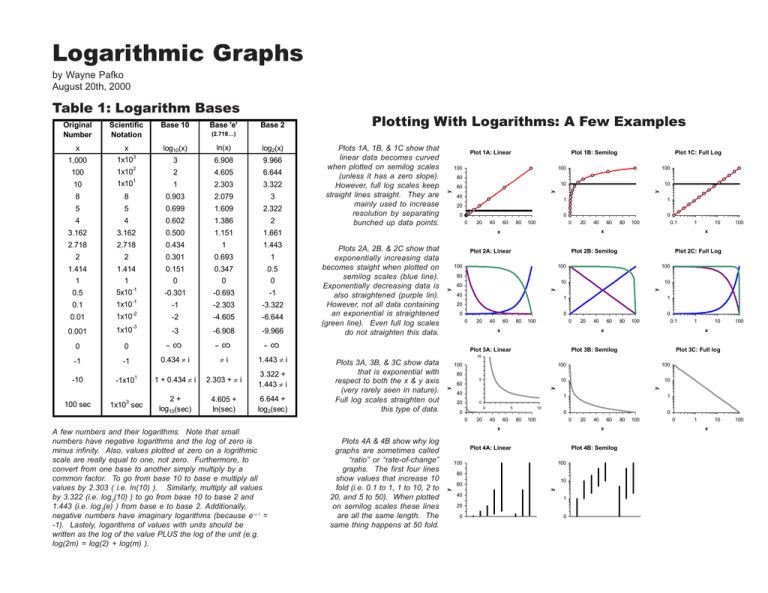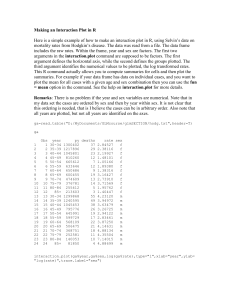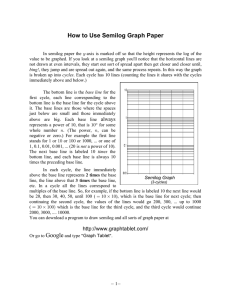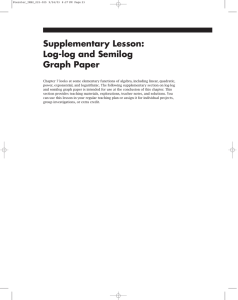Logarithmic Graphs Explained: Linear, Semilog, and Full Log Plots
advertisement

Logarithmic Graphs by Wayne Pafko August 20th, 2000 Table 1: Logarithm Bases Original Number Scientific Notation Base 10 x log10(x) ln(x) log2(x) 1,000 x 1x103 3 6.908 9.966 100 1x102 2 4.605 6.644 10 1x101 1 2.303 3.322 8 8 0.903 2.079 3 5 5 0.699 1.609 2.322 4 4 0.602 1.386 2 3.162 3.162 0.500 1.151 1.661 2.718 2.718 0.434 1 1.443 2 2 0.301 0.693 1 1.414 1.414 0.151 0.347 0.5 1 1 5x10-1 0 0 0 0.5 -0.301 -0.693 -1 0.1 1x10-1 -1 -2.303 -3.322 0.01 1x10-2 -2 -4.605 -6.644 -3 -6.908 -9.966 0.434 π i πi 1.443 π i 2.303 + π i 3.322 + 1.443 π i 1x10 -10 100 sec Plot 1A: Linear Plot 1B: Semilog 100 100 100 10 10 40 y y 60 1 0 0 0 20 40 60 80 -1x10 1x103 sec 1 + 0.434 π i 2+ log10(sec) 4.605 + ln(sec) 6.644 + log2(sec) 20 40 Plots 3A, 3B, & 3C show data that is exponential with respect to both the x & y axis (very rarely seen in nature). Full log scales straighten out this type of data. 80 100 0.1 1 100 10 100 x Plot 2B: Semilog Plot 2C: Full Log 100 100 10 10 y y 60 40 y 80 1 1 20 0 0 0 20 40 60 80 0 0 100 20 40 60 80 100 0.1 1 x x 10 100 x Plot 3B: Semilog Plot 3C: Full log 10 100 100 100 10 10 80 5 60 40 1 20 0 0 20 5 40 60 10 80 0 40 60 Plot 4B: Semilog 100 80 10 y 60 y 20 x Plot 4A: Linear 1 20 0 0 0 100 100 40 1 0 x Plots 4A & 4B show why log graphs are sometimes called “ratio” or “rate-of-change” graphs. The first four lines show values that increase 10 fold (i.e. 0.1 to 1, 1 to 10, 2 to 20, and 5 to 50). When plotted on semilog scales these lines are all the same length. The same thing happens at 50 fold. 60 x Plot 2A: Linear 0 A few numbers and their logarithms. Note that small numbers have negative logarithms and the log of zero is minus infinity. Also, values plotted at zero on a logrithmic scale are really equal to one, not zero. Furthermore, to convert from one base to another simply multiply by a common factor. To go from base 10 to base e multiply all values by 2.303 ( i.e. ln(10) ). Similarly, multiply all values by 3.322 (i.e. log2(10) ) to go from base 10 to base 2 and 1.443 (i.e. log2(e) ) from base e to base 2. Additionally, negative numbers have imaginary logarithms (because e-π i = -1). Lastely, logarithms of values with units should be written as the log of the value PLUS the log of the unit (e.g. log(2m) = log(2) + log(m) ). 0 0 100 Plot 3A: Linear 1 1 20 x Plots 2A, 2B, & 2C show that exponentially increasing data becomes staight when plotted on semilog scales (blue line). Exponentially decreasing data is also straightened (purple lin). However, not all data containing an exponential is straightened (green line). Even full log scales do not straighten this data. Plot 1C: Full Log 80 y Plots 1A, 1B, & 1C show that linear data becomes curved when plotted on semilog scales (unless it has a zero slope). However, full log scales keep straight lines straight. They are mainly used to increase resolution by separating bunched up data points. y 0 -1 Plotting With Logarithms: A Few Examples y 0 -1 Base 2 (2.718…) y 0.001 -3 Base 'e' 0 80 100 0 1 10 x 100





